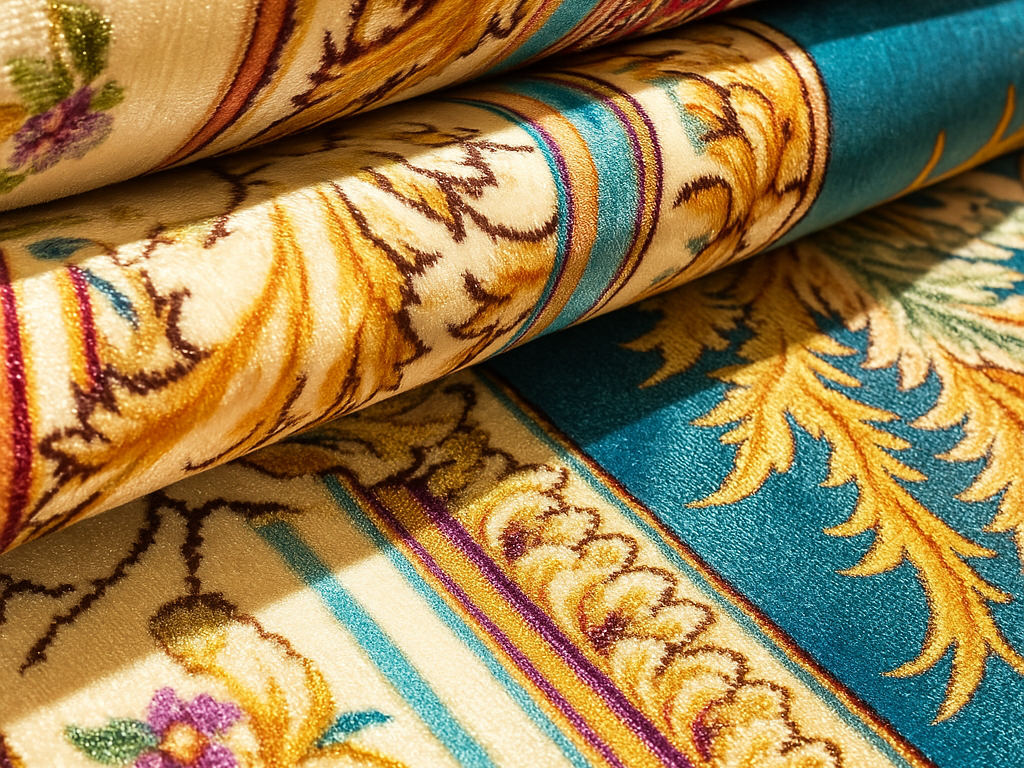Ese agudo clic-clac de los tacones sobre el suelo duro. El eco de las conferencias telefónicas rebotando en las paredes desnudas. La sensación fría e impersonal de un espacio de trabajo que agota la energía a las 3 de la tarde. Si el entorno de su oficina se enfrenta a estos problemas, la solución puede estar bajo sus pies, literalmente.
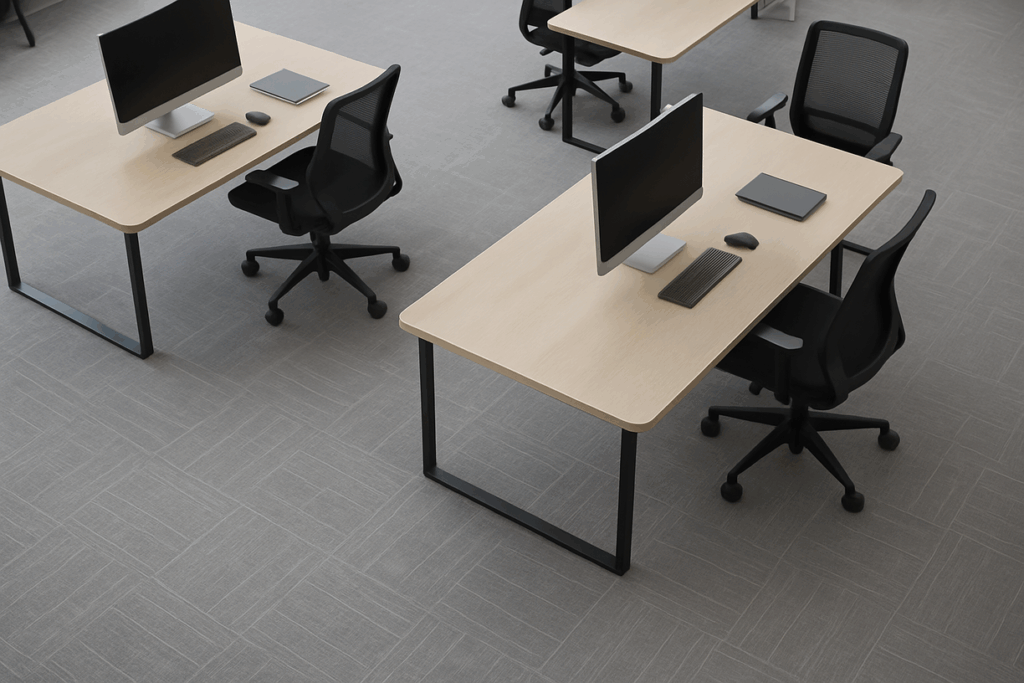
La moqueta de oficina es mucho más que un elemento decorativo. Es una herramienta de rendimiento estratégico diseñada para resolver problemas reales en el lugar de trabajo: reducir la contaminación acústica hasta en 50%, reducir los riesgos de resbalones en 65% e incluso mejorar la calidad del aire atrapando los alérgenos. Más allá de su función, es un embajador de marca silencioso que utiliza la psicología del color para impulsar la creatividad o proyectar prestigio corporativo.
En esta guía definitiva, analizamos desde alfombras ergonómicas para zonas de mucho tránsito hasta sistemas de baldosas acústicas que transforman los caóticos espacios abiertos en centros de atención.
1. Alfombras de oficina
Las alfombras de oficina son más que meros elementos decorativos; forman parte integral de la creación de un espacio de trabajo funcional y estéticamente agradable. Estas alfombras cumplen múltiples funciones, desde mejorar la comodidad al pisarlas hasta reducir los niveles de ruido en entornos de oficina bulliciosos. También contribuyen a delimitar las distintas zonas de una oficina diáfana, facilitando la organización del espacio y la eficacia del flujo de trabajo.
Lectura relacionada: Cómo elegir el tamaño de alfombra adecuado: Guía por habitaciones
2. Por qué su oficina necesita una alfombra
Incorporar alfombras al entorno de su oficina ofrece numerosas ventajas que van más allá de la mera estética. Desde aumentar el confort hasta mejorar la acústica, las alfombras desempeñan un papel fundamental en la creación de un espacio de trabajo funcional y acogedor.
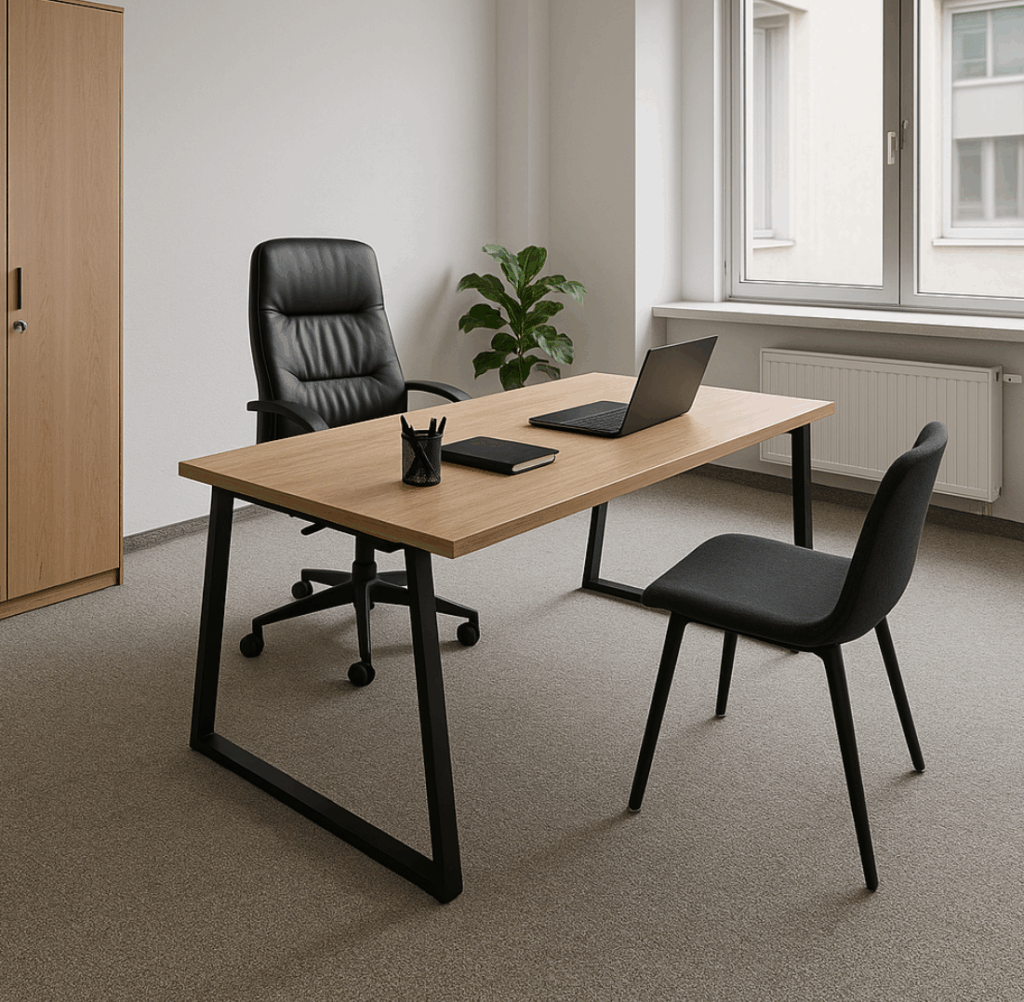
Mayor comodidad y ergonomía
Los suelos duros, como las baldosas o la madera, pueden ser implacables durante largas jornadas de trabajo. Las alfombras de oficina proporcionan una superficie acolchada que reduce la tensión en pies y articulaciones, contribuyendo al confort y bienestar general de los empleados. Esta mayor comodidad puede aumentar la productividad y reducir la fatiga del personal.
Acústica mejorada
La contaminación acústica es un problema común en las oficinas, sobre todo en las de planta abierta. Las alfombras ayudan a absorber el sonido, minimizando los ecos y reduciendo los niveles de ruido ambiental. Esto crea un entorno más silencioso, propicio para la concentración y la comunicación eficaz.
Estética y marca
Una alfombra bien elegida puede unir varios elementos de diseño, añadiendo calidez y personalidad al espacio de la oficina. También puede reflejar la identidad de marca de la empresa mediante la elección de colores y estampados, dejando una impresión duradera en clientes y visitantes.
Definición y organización del espacio
En los diseños de oficinas abiertas, las alfombras pueden utilizarse para delimitar distintas áreas funcionales, como puestos de trabajo, zonas de reunión y espacios de descanso. Esto ayuda a organizar el espacio de trabajo de forma eficiente y puede guiar el tráfico peatonal con eficacia.
Seguridad y protección del suelo
Las alfombras pueden evitar resbalones y caídas al proporcionar tracción, sobre todo en zonas muy transitadas. También protegen el suelo del desgaste, prolongando su vida útil y reduciendo los costes de mantenimiento.
Aislamiento térmico
Las alfombras añaden una capa extra de aislamiento al suelo, ayudando a mantener una temperatura agradable en la oficina. Esto puede ser especialmente beneficioso en climas fríos, ya que contribuye a la eficiencia energética y al confort de los empleados.
Lectura relacionada: Alfombras de comedor: Guía completa de selección, estilo y cuidado
3. Tipos de alfombras de oficina
Seleccionar la alfombra adecuada para su oficina implica encontrar un equilibrio entre estética, funcionalidad y mantenimiento. Los distintos tipos de alfombras ofrecen ventajas únicas adaptadas a las diversas necesidades de la oficina. A continuación le presentamos los tipos más comunes:
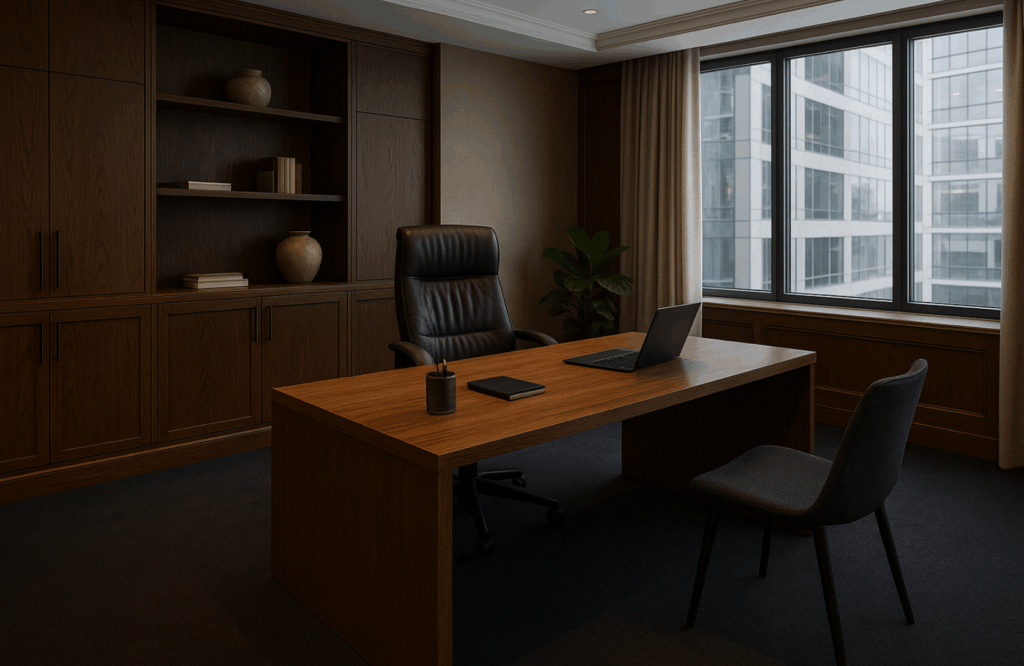
Seleccionar la alfombra adecuada para su oficina implica conocer los distintos tipos disponibles, cada uno de los cuales ofrece distintas ventajas en términos de funcionalidad, estética y mantenimiento. A continuación encontrará un resumen de los tipos de alfombras de oficina más comunes para orientarle en su elección:
Alfombras de pelo bajo
Las alfombras de pelo bajo tienen fibras cortas, lo que las hace ideales para oficinas en las que se utilizan con frecuencia sillas con ruedas. Su superficie plana permite un movimiento suave de las sillas de oficina y reduce el riesgo de tropiezos. Además, las alfombras de pelo corto son más fáciles de limpiar y mantener, por lo que son adecuadas para zonas muy transitadas.
Alfombras de tejido plano
Las alfombras de tejido plano, como los kilims y las dhurries, no tienen pelo, por lo que son finas y duraderas. Estas alfombras son ligeras, fáciles de limpiar y a menudo reversibles, lo que amplía su utilidad. Su tejido tupido las hace menos propensas a engancharse, lo que resulta beneficioso en entornos de oficina ajetreados.
Alfombras de interior/exterior
Diseñadas para soportar diversos elementos, las alfombras de interior/exterior están fabricadas con materiales duraderos como el polipropileno. Son resistentes a la humedad, las manchas y la decoloración, lo que las hace idóneas para oficinas que requieren soluciones de suelo fáciles de limpiar. Su versatilidad permite utilizarlas tanto en espacios de oficina interiores como semiexteriores.
Alfombras de yute y fibras naturales
Las alfombras de yute, fabricadas con fibras vegetales naturales, son una opción ecológica para el suelo. Proporcionan un aspecto texturizado y orgánico que puede añadir calidez a los espacios de oficina. Aunque son duraderas, es importante tener en cuenta que las alfombras de yute son más sensibles a la humedad y pueden requerir un mantenimiento más cuidadoso en comparación con las opciones sintéticas.
Alfombras de lana
Las alfombras de lana son conocidas por su suavidad y durabilidad. Resisten las manchas de forma natural y conservan su aspecto con el paso del tiempo, lo que las convierte en una opción duradera para las oficinas. Las propiedades aislantes de la lana también contribuyen a reducir el ruido, creando un entorno de trabajo más silencioso.
Alfombras de fibra sintética
Alfombras de fibras sintéticas como nylon o poliéster son rentables y ofrecen una gran resistencia a las manchas y al desgaste. Son fáciles de limpiar y mantener, lo que las hace idóneas para zonas de oficina muy transitadas. Las alfombras sintéticas están disponibles en una amplia gama de colores y diseños, lo que permite una mayor flexibilidad en el diseño de la oficina.
Moqueta
Las baldosas de moqueta son suelos modulares que pueden colocarse siguiendo distintos patrones y son fáciles de sustituir si se dañan. Ofrecen flexibilidad en el diseño y son prácticas para oficinas que pueden necesitar cambiar la distribución o sustituir secciones debido al desgaste.
Lectura relacionada: El arte del dibujo: Exploración de diseños en alfombras de nailon impresas
4. La psicología de marca de las alfombras de oficina
La elección de una alfombra de oficina puede influir sutilmente en la percepción de la marca de una empresa. Por ejemplo, una alfombra moderna y elegante puede transmitir innovación y visión de futuro, mientras que un diseño tradicional puede sugerir estabilidad y fiabilidad. Los tonos azules pueden evocar confianza y profesionalidad, mientras que los colores vivos, como el rojo o el naranja, pueden estimular la creatividad y la energía.
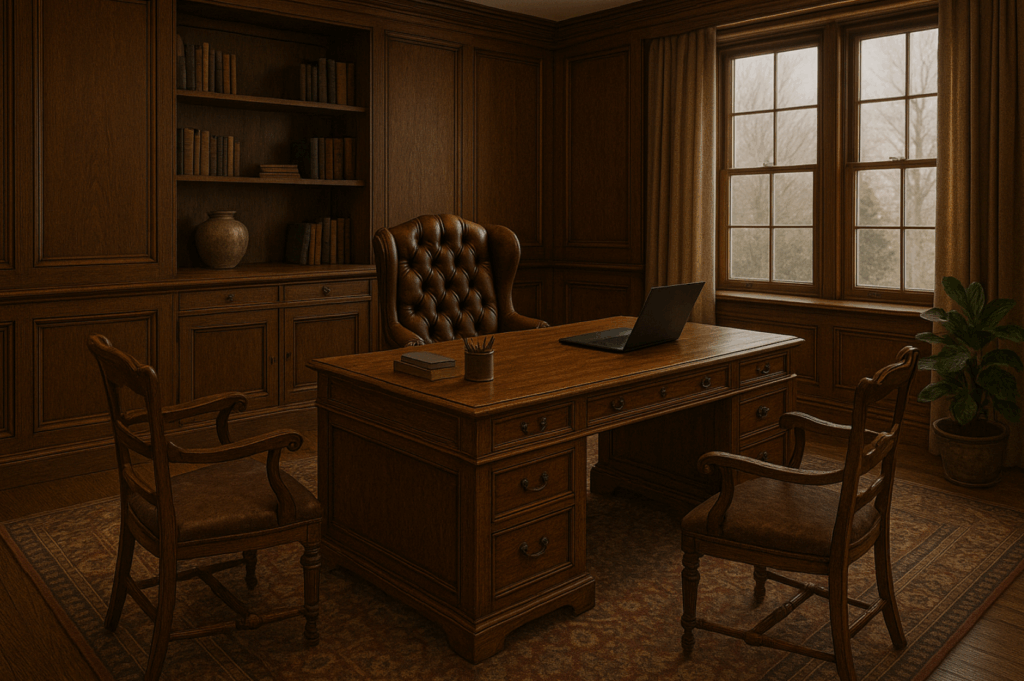
Ciencia del color y del dibujo
- Azules y grises profundos: Transmiten estabilidad y confianza, ideales para las finanzas (por ejemplo, bancos, bufetes de abogados).
- Geometría vibrante: Estimula la innovación en agencias tecnológicas o creativas. Las startups de Shenzhen que utilizan alfombras con patrones dinámicos informan de una generación de ideas 30% superior en las sesiones de brainstorming.
- Verdes biofílicos: Reducen el estrés en 17% cuando se integran con motivos naturales, perfectos para entornos sanitarios o de alto estrés.
Mesa: Psicología del color de la moqueta para industrias
| Industria | Colores recomendados | Psmpacto psicológico |
| Finanzas | Azul marino, Carbón, Borgoña | Confianza, autoridad |
| Tecnología/Creatividad | Amarillo cítrico, verde azulado, coral | Energía, Innovación |
| Sanidad | Salvia, Azul cielo, Terracota | Calma, Curación |
| Educación | Tonos tierra, rojos cálidos | Concentración, estimulación |
Oportunidades de personalización de marca
Las empresas con visión de futuro incorporan logotipos, declaraciones de misión o símbolos culturales a las alfombras de entrada. Por ejemplo, una empresa de tecnología financiera de Shanghái incrustó patrones de circuitos impresos en las alfombras de recepción, reforzando su espíritu tecnológico antes incluso de que los visitantes llegaran a la recepción.
5. Cómo elegir alfombras para su oficina
Elegir la alfombra adecuada para su oficina es un equilibrio entre estética, funcionalidad y sentido práctico. Una alfombra bien elegida puede aumentar el confort, definir espacios y reflejar la identidad de su marca. He aquí algunas consideraciones clave para guiar su selección:
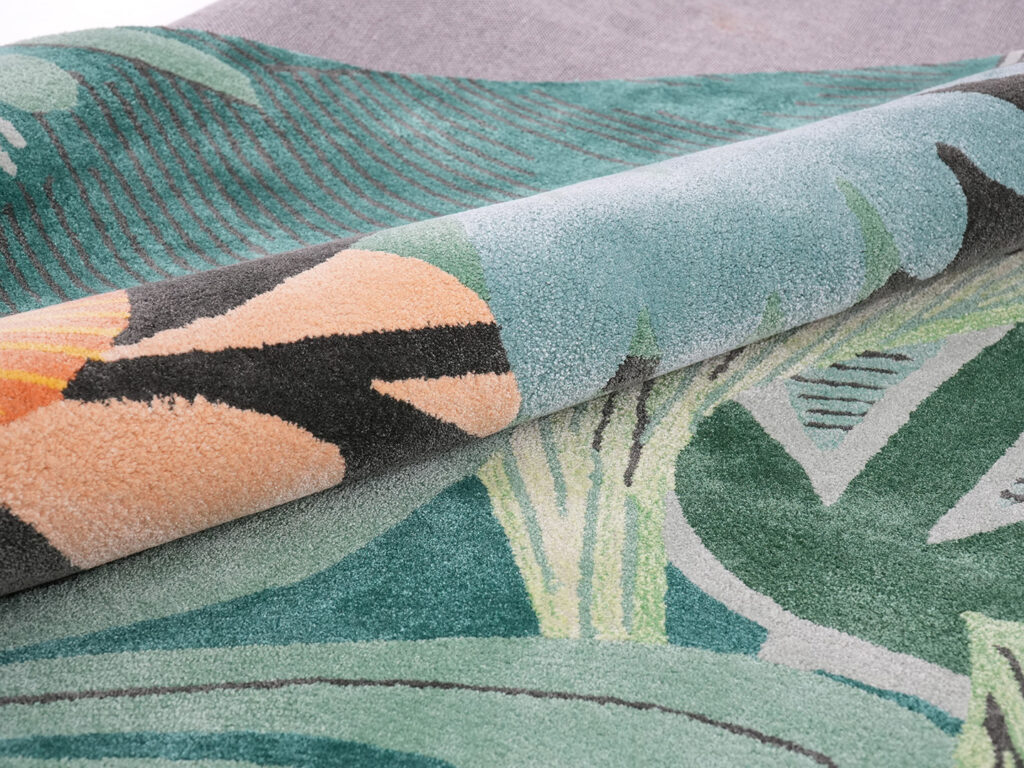
Evalúe el diseño y la finalidad de su oficina
- Definir zonas funcionales: Determine el propósito de la alfombra, ya sea anclar un área de escritorio, delinear un espacio de descanso o añadir calidez a una sala de conferencias.
- Medir con precisión: Tome las medidas exactas de la zona para asegurarse de que la alfombra se ajusta adecuadamente sin saturar el espacio ni parecer demasiado pequeña.
Elija el tamaño y la forma adecuados
- Escritorios: Opta por alfombras que se extiendan más allá del escritorio y la silla, permitiendo un movimiento cómodo.
- Zonas de asientos: Asegúrese de que la alfombra se adapte a todos los muebles de asiento, creando un aspecto cohesionado.
- Espacios abiertos: En oficinas diáfanas, utilice alfombras más grandes para delimitar zonas o caminos.
- Consideraciones sobre la forma: Seleccione alfombras con formas que complementen la distribución de su oficina: alfombras rectangulares para espacios tradicionales, alfombras redondas para zonas pequeñas o con formas singulares.
Seleccione los materiales adecuados
- Zonas de tráfico intenso: Elija materiales duraderos como el nailon o el polipropileno, que resisten el desgaste y son fáciles de limpiar.
- Zonas de confort: Para zonas donde el confort es primordial, como salones u oficinas privadas, considere las alfombras de lana o algodón por su suavidad y propiedades aislantes.
- Opciones ecológicas: Las fibras naturales como el yute o el sisal ofrecen sostenibilidad y una textura única, pero pueden requerir más mantenimiento.
Considere la altura y la textura de la pila
- Alfombras de pelo bajo: Ideales para zonas con sillas rodantes, ya que permiten moverse con facilidad y es menos probable que atrapen la suciedad.
- Alfombras de pelo largo: Ofrecen mayor comodidad y son adecuadas para zonas poco transitadas, pero pueden requerir una limpieza más frecuente.
- Textura: Seleccione texturas que se ajusten a las necesidades estéticas y funcionales de su oficina; por ejemplo, las alfombras de tejido plano ofrecen un aspecto elegante y son fáciles de mantener.
Colores y motivos acordes con la estética de la oficina
- Psicología del color: Elija colores que reflejen el ambiente deseado: azul para la calma, verde para la creatividad o tonos neutros para un aspecto profesional.
- Patrones: Incorpore motivos que complementen la decoración de su oficina; los motivos sutiles pueden añadir interés sin abrumar el espacio, mientras que los diseños atrevidos pueden servir como puntos focales.
Factor de mantenimiento y durabilidad
- Facilidad de limpieza: Seleccione alfombras fáciles de limpiar, especialmente en zonas muy transitadas.
- Resistencia a las manchas: Considere alfombras con propiedades resistentes a las manchas para mantener su aspecto con el paso del tiempo.
- Longevidad: Invierta en alfombras de alta calidad que resistan el desgaste diario y mantengan su aspecto y tacto.
Consideraciones presupuestarias
- Coste frente a calidad: Equilibre su presupuesto con la necesidad de durabilidad y atractivo estético.
- Inversión a largo plazo: Tenga en cuenta la vida útil de la alfombra y los costes de mantenimiento a la hora de evaluar su valor global.
6. Consejos de mantenimiento para alfombras de oficina
El mantenimiento adecuado de las alfombras de oficina es esencial para conservar su aspecto, garantizar un entorno de trabajo saludable y prolongar su vida útil. Estos son algunos consejos para mantener las alfombras de oficina en perfecto estado:
- Aspiración regular: Mantenga las alfombras limpias aspirándolas al menos una vez a la semana para eliminar la suciedad y los restos.
- Limpieza de manchas: Solucione inmediatamente los derrames para evitar las manchas. Utilice soluciones de limpieza adecuadas en función del material de la alfombra.
- Limpieza profesional: Programe periódicamente una limpieza profesional a fondo para mantener el aspecto y la longevidad de la alfombra.
- Rota las alfombras: Rote las alfombras cada pocos meses para garantizar un desgaste uniforme, especialmente en zonas de mucho tránsito.
- Utilice alfombrillas: Coloque almohadillas debajo de la alfombra para evitar resbalones y proporcionar una amortiguación adicional.
7. Coste de las alfombras de oficina
El coste de las alfombras de oficina varía mucho en función del tamaño, el material y el diseño. Las más económicas pueden costar a partir de $50, mientras que las de gama alta, fabricadas con materiales de primera calidad, pueden costar varios cientos de dólares o más. Invertir en alfombras de calidad puede ofrecer beneficios a largo plazo en términos de durabilidad y atractivo estético.
8. Conclusión
Las alfombras de oficina son un valioso complemento para cualquier espacio de trabajo, ya que ofrecen ventajas que van más allá de la mera decoración. Aumentan el confort, reducen el ruido, contribuyen a la seguridad y reflejan la identidad de la marca. Seleccionando cuidadosamente el tipo, material y diseño adecuados, y manteniéndolas correctamente, las alfombras de oficina pueden mejorar significativamente la funcionalidad y el ambiente del lugar de trabajo.
9. Preguntas frecuentes
P1: ¿Qué tamaño de alfombra es mejor para debajo de una mesa de oficina?
Una alfombra que se extienda al menos 24 pulgadas más allá del escritorio en todos los lados es ideal para acomodar el movimiento de la silla.
P2: ¿Son mejores las alfombras de pelo bajo para las sillas de oficina con ruedas?
Sí, las alfombras de pelo bajo facilitan el movimiento de las sillas de ruedas y son menos propensas a provocar tropiezos.
P3: ¿Con qué frecuencia deben limpiarse profesionalmente las alfombras de oficina?
Se recomienda realizar una limpieza profesional de las alfombras de oficina cada 12 o 18 meses, en función del tráfico y el uso.
P4: ¿Pueden las alfombras mejorar la acústica de la oficina?
Absolutamente. Las alfombras absorben el sonido, reduciendo el eco y los niveles de ruido, lo que puede aumentar la concentración y la productividad.
P5: ¿Existen opciones de alfombras ecológicas para oficinas?
Sí, las alfombras de fibras naturales como la lana, el yute o el bambú son opciones ecológicas que además aportan una estética natural a la oficina.

